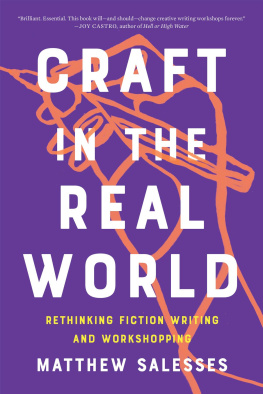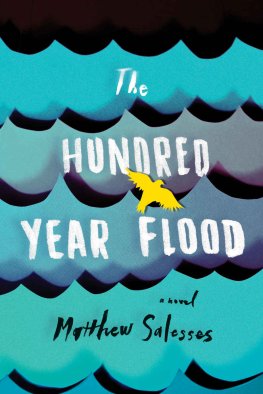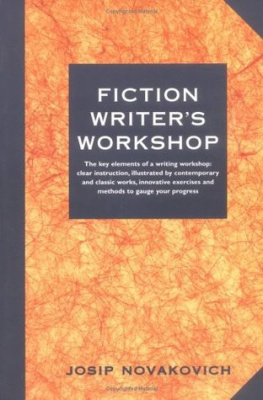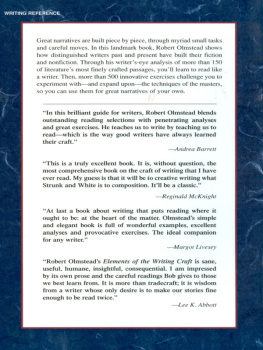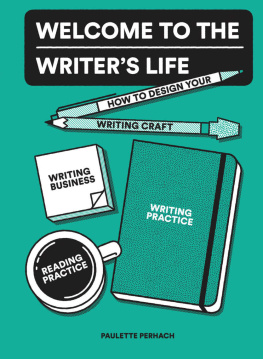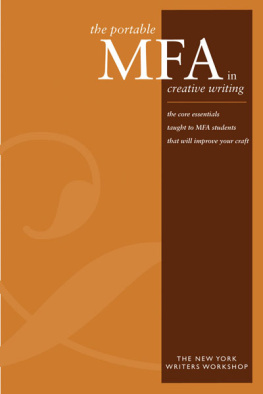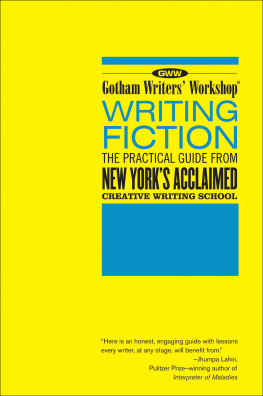Table of Contents
Guide
Page List
PRAISE FOR MATTHEW SALESSES
Craft in the Real World
This book is a gift to those writers whove felt the tilt of imbalanced power in a workshop, whove wondered whose rules theyre following when they write and why, whove struggled to tell their stories within a narrow and restrictive tradition. With empathy and keen insight, Matthew Salesses delivers an unflinching critique of the pedagogy of creative writings old guardand models a way of studying and communicating craft that is self-aware, socially engaged, and thrillingly alive.
ALEXANDRA KLEEMAN , author of Intimations
This is exactly the book we need right nowa vital corrective to the myth that craft is a neutral, objective category unaffected by historical or cultural context. Matthew Salesses explores how beliefs about good writing are profoundly marked by race, class, gender, sexuality, ability, and national identity; and he offers concrete strategies for liberating our classrooms and writing practices from the straight-white-male default gaze. I will recommend Craft in the Real World to every writer and teacher I know.
LENI ZUMAS , author of Red Clocks
With Craft in the Real World, Matthew Salesses has created a tremendous resource for anyone hoping to write fiction or teach fiction writing. It tackles head-on how craft has often been taught in the United States, and like the best teachers, it provides a practical path for much needed reform and improvement. This book teaches us how to ask better questions of our craft, our work, our workshops, and of each other. To have all of this pedagogical brilliance and thoughtfulness in one book is a gift.
JENNINE CAP CRUCET , author of My Time Among the Whites
Our students put their hearts on pages and they hand those pages to us. Its a profound act of trust and Matthew Salesses shows us how to be worthy of it. Craft in the Real World is required reading for writers, writing teachers, and everyone who loves language and what it can accomplish in our beautiful, complicated world.
MEGAN STIELSTRA , author of The Wrong Way to Save Your Life
Disappear Doppelgnger Disappear
Inventive and profound, mordantly hilarious and wildly moving. Matthew Salesses is one of my all-time favorite writers.
LAURA VAN DEN BERG , author of I Hold a Wolf by the Ears
A remarkable, entertaining... achievement. Look out for it.
VIET THANH NGUYEN , author of The Sympathizer
Like everything Matthew Salesses writes, this book grabbed me on page one and didnt let go.
NICOLE CHUNG , author of All You Can Ever Know
An absolute masterpiece from a stunningly singular voice.
KIRSTIN CHEN , author of Bury What We Cannot Take
A book of breathtaking depth and scope. A miraculous achievement.
CATHERINE CHUNG , author of The Tenth Muse
The Hundred-Year Flood
This beautiful debut novel by Matthew Salesses is... epic and devastating and full of natural majesty.
ROXANE GAY , author of Bad Feminist
Matthew Salesses is a new force of nature.
MAT JOHNSON , author of Loving Day
I fell under the spell of his lovely novel... The Hundred-Year Flood is a vivid, cunning, compelling narrative about inheritance and forgiveness. A wonderful debut.
MARGOT LIVESEY , author of The Boy in the Field
Admirable for what it tackles, for the depth of its subject, for the risks it takes with structure.
The Rumpus
This is an engulfing read.
Publishers Weekly
CRAFT IN THE REAL WORLD
ALSO BY MATTHEW SALESSES
Disappear Doppelgnger Disappear
The Hundred-Year Flood: A Novel
Im Not Saying, Im Just Saying: A Novel
The Last Repatriate: A Novella
Our Island of Epidemics
Different Racisms: On Stereotypes, the Individual, and Asian American Masculinity
We Will Take What We Can Get

To all of my teachers and students,
especially M.L. and M.J.
CONTENTS
This book is a challenge to accepted models of craft and workshop, to everything from a character-driven plot to the cone of silence, or gag rule, that in a creative writing workshop silences the manuscripts author. The challenge is this: to take craft out of some imaginary vacuum (as if meaning in fiction is separate from meaning in life) and return it to its cultural and historical context. Race, gender, sexuality, etc. affect our lives and so must affect our fiction. Real-world context, and particularly what we do with that context, is craft.
Over a decade ago, I sat silently in an MFA workshop while mostly white writers discussed my race. I had decided not to name the race of any character, Asian American or otherwisebut the workshop demanded that the story inform the reader if my characters were like me, people of color. A common assumption lies behind this phenomenon: that no mention of race is supposed to mean a character is white. I didnt have to ask why the white writers in the room never identified the race of their white characters. I already knew why: they believed that white is literatures default. I just couldnt say so.
To name or not name a characters race is a matter of craft. To consider a character to be white unless stated otherwise is a matter of craft. Since this is a craft book, lets explore what exactly is at stake for the craft of fiction here. There are three possibilities:
- If fiction dictates that a writer identify only the race of non-white characters, then craft is a tool used to normalize whiteness.
- If race is a factor only in stories with characters of color, then craft must be different for fiction with characters of color than it is for fiction with white characters.
- Otherwise, if any mention of race affects a story, then, like setting, race must be a part of any craft discussion.
Our current methods of teaching craft date back to at least 1936 and the creation of the Iowa Writers Workshop, the first MFA program. The Workshop rose to prominence under the leadership (19411965) of Paul Engle, a white poet from Cedar Rapids, Iowa, who was invested in what scholar Eric Bennett calls Iowa as the home of the free individual, of the poet at peace with democratic capitalism, of the novelist devoted to the contemporary outlines of liberty. (You will find more about this history later in the book.) In other words, the Workshop never meant craft to be neutral. Craft expressed certain artistic and social values that could be weaponized against the threat of Communism.
Craft is part of the history of Western empire that goes back even to the Ancient Greek and Roman empires, upon which American democratic values are based. We still talk about plot the way Aristotle wrote about it over two thousand years ago, when he argued that plot should be driven by character. When we continue to teach plot this way, we ignore both the many other kinds of plot found in literatures around the world and even the context of Aristotles original complaint (he was fed up with the fate/god-driven plots popular with tragedians of his time).
What we call craft is in fact nothing more or less than a set of expectations. Those expectations are shaped by workshop, by reading, by awards and gatekeepers, by biases about whose stories matter and how they should be told. How we engage with craft expectations is what we can control as writers. The more we know about the context of those expectations, the more consciously we can engage with them.

